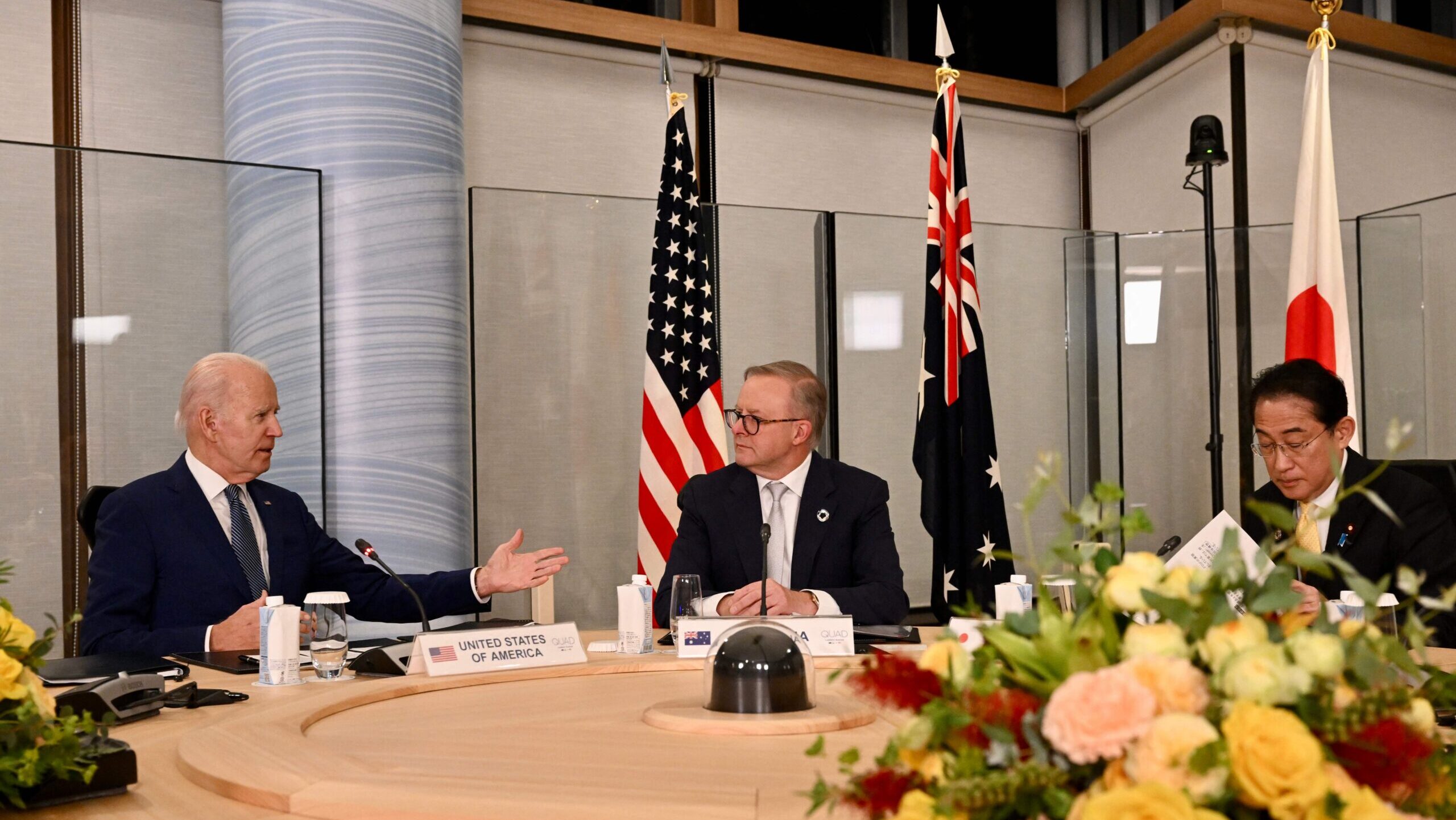
US President Joe Biden, Australia’s Prime Minister Anthony Albanese and Japan’s Prime Minister Fumio Kishida on the sidelines of the G7 Leaders’ Summit in Hiroshima on May 20, 2023. (Kenny HOLSTON / POOL / AFP)
WASHINGTON — The United States and Australia this week announced plans to deepen their cooperation with Japan on uncrewed aircraft systems (UAS), specifically involving collaborative combat aircraft — a family of drones officials plan to fly alongside fighter jets in combat.
Although light on details, the announcement, made Wednesday during a state visit by Australian Prime Minister Anthony Albanese, will likely intrigue American firms that are already targeting CCA efforts for both the US Air Force and Navy.
“Today, we announce our intention to explore trilateral cooperation with Japan on Unmanned Aerial Systems. Our cooperation aims to enhance interoperability and accelerate technology transfer in the rapidly emerging field of collaborative combat aircraft and autonomy,” the White House said.
The Biden Administration’s announcement came on the heels of a speech by Kyosuke Matsumoto, a Japanese defense ministry official, at the ComDef conference in Washington. During his address, Matsumoto highlighted several cooperative projects like Japan’s partnership on the European-heavy GCAP advanced fighter program and with the US on the Glide Phase Interceptor effort, detailing how Japan’s involvement in defense projects with the West would only grow.
“We will advance cooperation with the United States regarding R&D of UAVs that we will operate with cruise fighters,” Matsumoto said, a description that certainly fits with CCA, which are supposed to operate alongside fighter jets.
The United States and Australia have previously collaborated on drone technologies, as well as uncrewed wingman applications. One example is Boeing’s MQ-28 Ghost Bat, a “loyal wingman” drone developed for the Royal Australian Air Force. US Air Force officials have expressed interest in the platform to leverage work on uncrewed technologies, which Boeing debuted on US soil this summer.
RELATED: Air Force eyes thrust range targets for wingman drones, wants engine development to start in FY25
Japan has also been in discussions about CCA-style drones as part of the GCAP effort, a partnership with the UK and Italy. But the US is very specifically not part of that effort, and whether Japan’s work with one side or the other can bleed across will have to be seen.
“While we work very closely with our Japanese allies to develop future capabilities that support our shared security interests, we don’t have any additional information or details to provide on the below at this time,” Jeff Jurgensen, a Pentagon spokesman, told Breaking Defense on Wednesday ahead of the White House’s announcement when asked about Matsumoto’s comments.
“Sharing CCA technologies between the US, Australia, and Japan could accelerate the transition to the next generation of UAS: AI-enabled uncrewed aircraft that can operate collaboratively with other UAS as well as crewed aircraft,” Mark Gunzinger, director of future concepts & capability assessments at the Mitchell Institute, told Breaking Defense in an email.
He sees benefits for all involved. For the US and Australia, increasing use of CCAs could help with sheer capacity of aircraft on the ramp, particularly as the US Air Force grapples with a shrinking fighter force. For Japan, it could specifically aid in keeping hours down from repeated scrambles to deal with jets in their airspace.
“The pace of day-to-day operations such as alert ‘scrambles’ in response to foreign aircraft can take a toll over time on the JASDF’s [Japan Air Self-Defense Force] fighter forces,” Gunzinger said, citing numbers that Japan flew 238 scrambles in Q1 2023, two-thirds of which were against Chinese aircraft and the rest against Russian aircraft. “CCAs could accompany manned fighters on scrambles, extending the range of their sensors and possibly reducing the number of fighters needed to support air sovereignty missions over time.”
As for all three countries’ industrial bases, “sharing CCA technologies — possibly including manufacturing know-how — could create a multilateral industrial base that is more resilient and better capable of surging CCA production in a crisis,” Gunzinger added. “Japan has a strong industrial base, and taking advantage of it for CCA development and production is a win-win-win.”






















